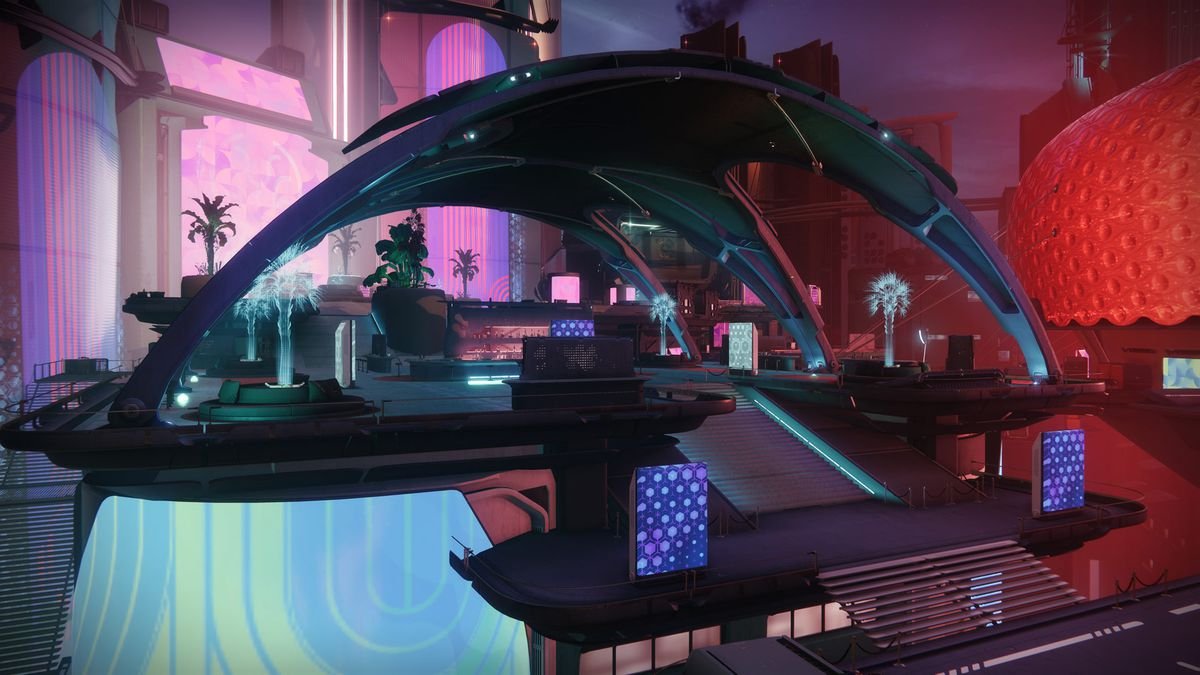During the first mission of Bungie’s newest Destiny 2 expansion, Lightfall, having hijacked an enemy spaceship and set it to self-destruct, I came across a familiar-looking hangar bay on my way out. In its two-tiered layout, its gaggle of room-filling purple ships and its wall-length energy shields leading out to space, it resembled nothing so much as the Covenant hangars Master Chief invaded in one of Bungie’s earliest games: Halo: Combat Evolved.
Deliberate or not, this visual double-take reminds me that Destiny 2 is a game in conversation with a long history. Leaving aside Bungie’s earlier games, Lightfall has arrived at the tail end of a 20-year span that Halo originated. While Destiny 2 today may be mostly unrecognizable in its polish and mechanical complexity compared to Bungie’s 2001 megahit, if you know where to look, it’s easy to see; in the level design, the monsters, and the guns (homages of which made their way into Destiny 2’s 30th Anniversary update), you can see the layers and layers of history.
In many ways, Destiny 2 is made for those of us who might notice the evidence of this history, who might even spend two paragraphs of a Lightfall review talking about a totally separate Bungie title. After all, it’s always been a game with one foot stuck in the past. Deep in its menus are pages dedicated to “Moments of Triumph” and “Seals” commemorating all you’ve achieved in the six years since the game’s original release. Destiny 2 continuously celebrates its history even as it continues to erase it elsewhere.

Image: Bungie
Most of Destiny 2’s moments are no longer accessible. Old campaigns are sunset as new ones are released. To experience the game is to experience the perpetual present: a present built from the narrative and mechanical raw matter of the recent past. Lightfall exemplifies this recursive trend.
The expansion’s story reaches all the way back to the very first moments of the original Destiny, back when we all looked up in wonder at that giant white ball called the Traveler hovering Damocles-like over humanity’s Last City. Lightfall begins to answer the question of “What is The Traveler’s deal, anyway?” At the campaign’s outset, it leaps dramatically into action — as much as a moon-sized sphere possibly can — launching itself into Earth’s orbit and challenging its old enemy, the Witness. What was once an inscrutable, passive entity now has become an active participant in the course of events. While still mostly a mystery, we have now seen the Traveler change things, and become changed itself in turn.
The mechanical act of playing Lightfall similarly feels like a combination of the old and the new. Aside from an armory of new weapons with a wide variety of perks (as is the norm in any of Bungie’s expansions), the campaign also grants players a new super ability called Strand. With Strand, players can grapple through the air and, among other things, hook onto enemies and slam into them with a satisfying explosion. In Strand’s extreme mobility and its reuse of Destiny’s familiar action of grabbing and dunking orbs, you can see the shapes and behaviors of previous mechanics. Strand doesn’t reinvent as much as it reconfigures how the game used to function. It also, helpfully, makes old content feel refreshing again, particularly for players who’ve gone through it all before ad nauseam. New life is breathed into old Strikes and Gambit sessions, which can now be approached from a new airborne perspective, unburdened by gravity or — judging by how easy it is to fling yourself off a ledge — common sense.

Image: Bungie
Lightfall’s setting is where it takes its biggest departure from Destiny’s past. You may start the campaign in the throes of battle around Earth’s orbit, but you’re almost immediately shuttled across the solar system to the planet Neptune, a wholly new addition to Destiny’s locales. Its city, Neomuna, which serves as Lightfall’s primary location, is a slick futurescape draped in colorful, cartoon neon and soundtracked by synths and playful drum riffs. Its Frankenstein-ed aesthetic of cyberpunk, and the funky sci-fi patina that feels inspired by comics like Silver Surfer and Guardians of the Galaxy, makes a welcome addition to Destiny 2’s already broad visual patchwork. Your main point of contact is memorably goofy: Nimbus, an 8-foot-tall nonbinary humanoid clad in a chrome, Hajime Sorayama-esque outfit complete with a bitchin’ codpiece.
Though Neomuna is new, the villain that threatens it, the Cabal ex-emperor Calus, is quite old. A version of Calus hosted Destiny 2’s very first raid. I still remember struggling through those late-night sessions, attempting to beat it with my original, now defunct, clan: bashing our heads against the raid’s seemingly impossible puzzles, Calus’ growling reptilian laughter echoing through our sleep-deprived skulls. That Calus is brought low in Lightfall, and turned into a pawn of the Witness, is made richer partially because we once got to see him at his height.
But what about new players with only a passing knowledge of Destiny 2’s extensive lore and backstory? Getting into the game itself is relatively straightforward. After playing through the tutorial missions introduced back in the New Light update, it’s possible to jump directly into the Lightfall campaign. And the cinematic that introduces’ Lightfall’s story does an admirable job of catching us up on the relevant story beats leading up to the current moment. The gameplay itself remains exciting, the encounters mostly very well designed, though unfortunately not as tense and exhilarating as some of what we saw in the previous expansion, The Witch Queen. On a purely functional level, and for many players, this should all be enough, right?

Image: Bungie
I’m not so sure. At the end of the day, Destiny 2 lives and dies by its sense of history, by the dedication of its loyal player base in recognizing and being recognized by that history. The power of playing through the recycled and reconfigured components of campaigns past is derived from remembering how it used to feel, and in being able to celebrate how it has since changed.
Considering that Lightfall’s story ends with many open-ended questions and is just the beginning of a year’s worth of narrative and gameplay content, which demands a level of time investment that many new players might balk at, it’s difficult to know whether the gameplay and the artwork — polished as they are — will be enough to draw in the uninitiated. Are they willing, once the campaign wraps up, to begin grinding, to devote themselves to this world that mostly ignores them, choosing to commemorate its “Veterans” (the title awarded to players who started playing six years ago) instead? There’s certainly something impressive about a game like Destiny 2, which has a history of its own, but also one that dates back to past franchises. But it leaves one wondering if there’s space at all for those who have no relationship with that history — who approach the game as visitors, witnessing just a sliver of what must feel like a lifetime of memories.
Destiny 2: Lightfall was released on Feb. 28 on PlayStation 4, PlayStation 5, Windows PC, Xbox One, and Xbox Series X. The game was reviewed on PS5 using a pre-release download code provided by Bungie. Vox Media has affiliate partnerships. These do not influence editorial content, though Vox Media may earn commissions for products purchased via affiliate links. You can find additional information about Polygon’s ethics policy here.
























































